NASA’s Ingenuity Mars helicopter stands on the Red Planet’s surface, Images from Mars by Perseverance Rover, common science, NASA Jet Propulsion Laboratory, Smithsonian National Air and Space Museum, and History
NASA’s Ingenuity Mars helicopter stands on the Red Planet’s surface.
The images show the flight zone of NASA’s Ingenuity Helicopter from the perspective of NASA’s Mars 2020 Perseverance rover and more.
Preparing for First Flight on Mars on This Week @NASA – March 26, 2021, NASA
See the Earth Mission NISAR Under Construction in JPL’s Clean Room, Mar 26, 2021, NASA Jet Propulsion Laboratory
Mars in 4k: Images from Mars by Perseverance Rover, Mar 28, 2021, common science
Mars 2020 and the Importance of Planetary Protection, Streamed live on Mar 23, 2021, Smithsonian National Air and Space Museum
NASA Previews First Flight of Mars Helicopter (Media Briefing), Streamed live on Mar 23, 2021, NASA Jet Propulsion Laboratory
The Universe: Human Life on Mars is Coming Soon (S2, E13) | Full Episode | History, Mar 22, 2021
NASA Ingenuity Mars Helicopter Prepares for First Flight
NASA’s Mars Helicopter, Ingenuity (UHD Trailer), Apr 29, 2020, NASA Jet Propulsion Laboratory
https://www.nasa.gov/press-release/nasa-to-host-briefing-to-preview-first-mars-helicopter-flights
In this illustration, NASA’s Ingenuity Mars helicopter stands on the Red Planet’s surface as NASA’s Perseverance rover (partially visible on the left) rolls away.
Credits: NASA/JPL-Caltech
NASA will hold a virtual media briefing at 1:30 p.m. EDT (10:30 a.m. PDT) Tuesday, March 23, to discuss upcoming activities for the agency’s Ingenuity Mars helicopter. The teams operating Ingenuity and NASA’s Mars 2020 Perseverance rover have chosen the flight zone where the helicopter will attempt the first powered, controlled flights on another planet.
The briefing will air live on NASA Television, the NASA app, and the agency’s website and will livestream on multiple agency social media platforms, including the YouTube and Facebook channels for NASA’s Jet Propulsion Laboratory in Southern California.
Briefing participants include:
- Lori Glaze, director of NASA’s Planetary Science Division, NASA Headquarters
- Bobby Braun, director for planetary science, JPL
- J. (Bob) Balaram, Ingenuity chief engineer, JPL
- Håvard Grip, Ingenuity chief pilot, JPL
- Farah Alibay, Perseverance integration lead for Ingenuity, JPL
To participate in the briefing by telephone, reporters must provide their name and affiliation by 11:30 a.m. EDT (8:30 a.m. PDT) Tuesday, March 23, to Rexana Vizza at rexana.v.vizza@jpl.nasa.gov.
Media and the public also may ask questions on social media during the briefing using #MarsHelicopter.
Ingenuity’s test flights are expected to begin no earlier than the first week of April. The exact timing of the first flight will remain fluid as engineers work out details on the timeline for deployments and vehicle positioning of Perseverance and Ingenuity. Photos showing some of the progress are available on Perseverance’s raw images website.
Perseverance – with Ingenuity attached to its belly – landed in Jezero Crater Feb. 18. Ingenuity is a technology demonstration with a limited test flight duration of up to 31 days (30 Mars days, or sols). The rover will deploy the helicopter and provide environmental monitoring and imaging support. It also hosts Ingenuity’s base station, enabling communication with mission controllers on Earth.
An Ingenuity press kit, with more information about the helicopter, is available at:
https://go.nasa.gov/ingenuity-press-kit
More information is also available on the Ingenuity website:
https://mars.nasa.gov/technology/helicopter
To learn more about Perseverance, visit:
and
https://mars.nasa.gov/mars2020/
-end-
Grey Hautaluoma / Alana Johnson
NASA Headquarters, Washington
202-358-0668 / 202-358-1501
grey.hautaluoma-1@nasa.gov / alana.r.johnson@nasa.gov
Jia-Rui Cook
Jet Propulsion Laboratory, Pasadena, Calif.
818-354-5011
jccook@jpl.nasa.gov
Last Updated: Mar 17, 2021
Editor: Sean Potter
Tags: Jet Propulsion Laboratory, Mars, Moon to Mars, Perseverance Mars Rover
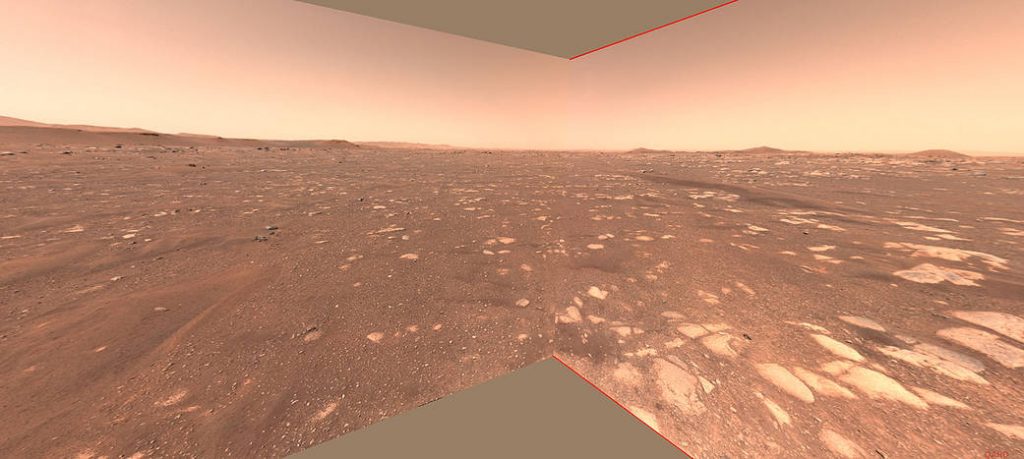 Rover Point of View of Ingenuity Flight Zone
Rover Point of View of Ingenuity Flight Zone
This image shows the flight zone of NASA’s Ingenuity Helicopter from the perspective of NASA’s Mars 2020 Perseverance rover.
Orville Wright makes the first powered, controlled flight on Earth as his brother Wilbur looks on in this image taken at Kitty Hawk, North Carolina, on Dec. 17, 1903.
 Perseverance Rover Drops its Debris Shield
Perseverance Rover Drops its Debris Shield
The debris shield, a protective covering on the bottom of NASA’s Perseverance rover, was released on March 212021.
 Perseverance on Mars Helicopter Above
Perseverance on Mars Helicopter Above
This illustration depicts Mars Helicopter Ingenuity during a test flight on Mars.
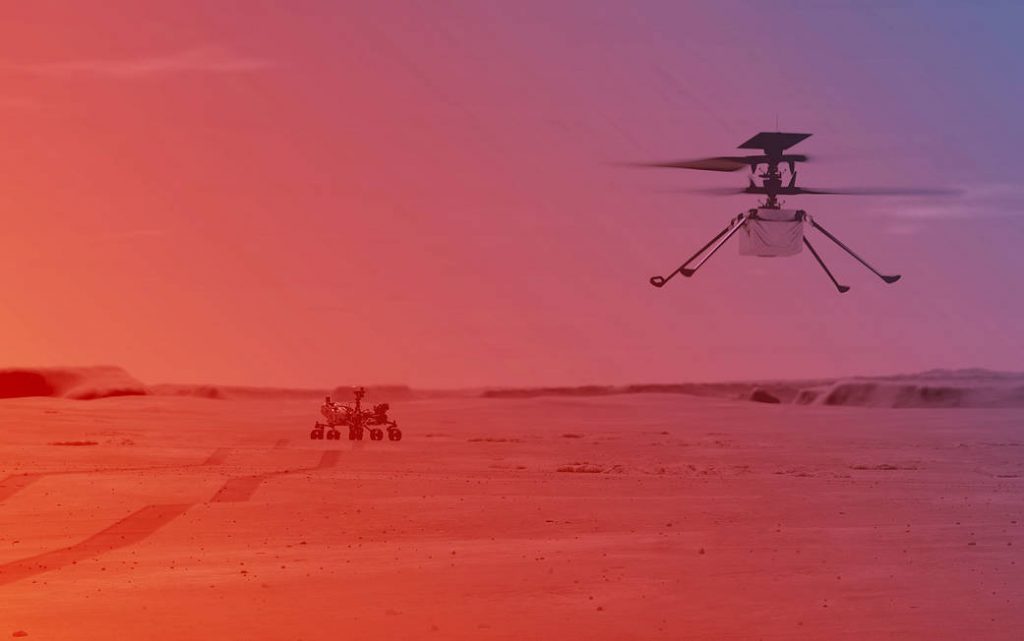 Ingenuity Helicopter on Mars (Illustration)
Ingenuity Helicopter on Mars (Illustration)
An illustration of NASA’s Ingenuity Helicopter flying on Mars
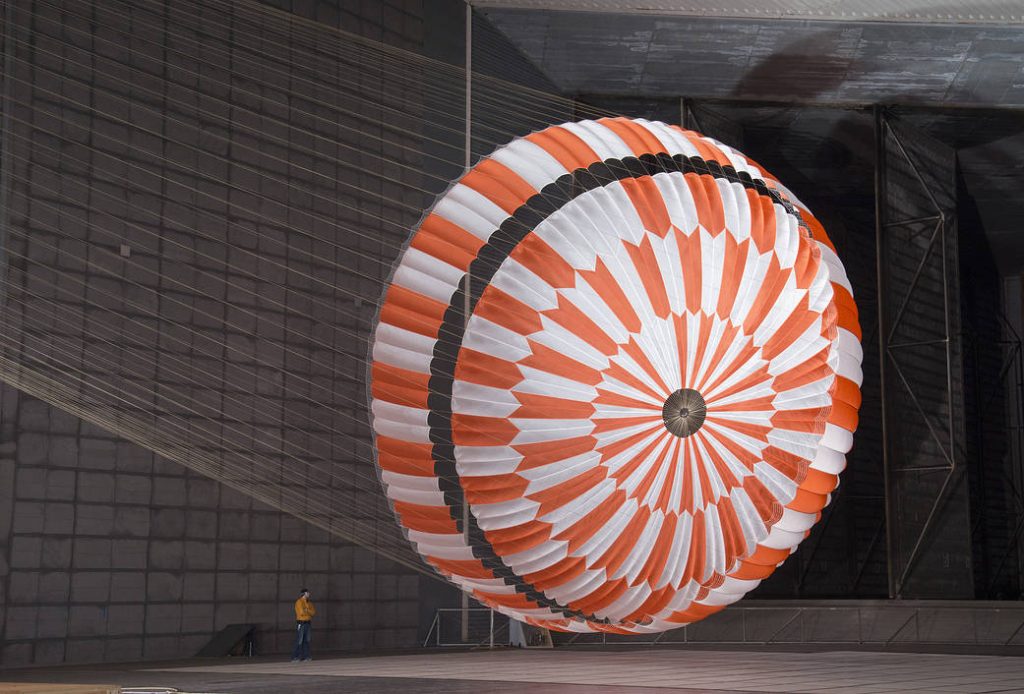
Run 03.
Requesters: Gregorio Villar, Chris Tanner.
Photographer: T. Wynne
Date: 02-JUN-2017
Photolab order: 070915-154126
NASA Needs Pi!
NASA uses pi every day!
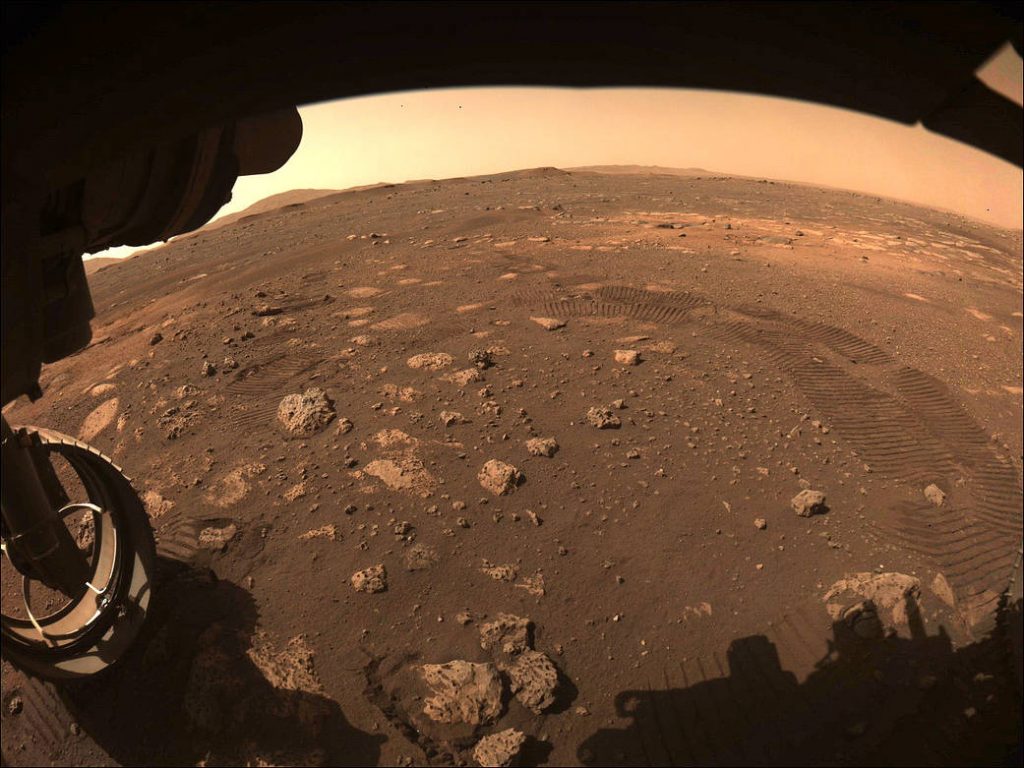 Perseverance Hazcam First Drive
Perseverance Hazcam First Drive
This image was captured while NASA’s Perseverance rover drove on Mars for the first time on March 4, 2021.
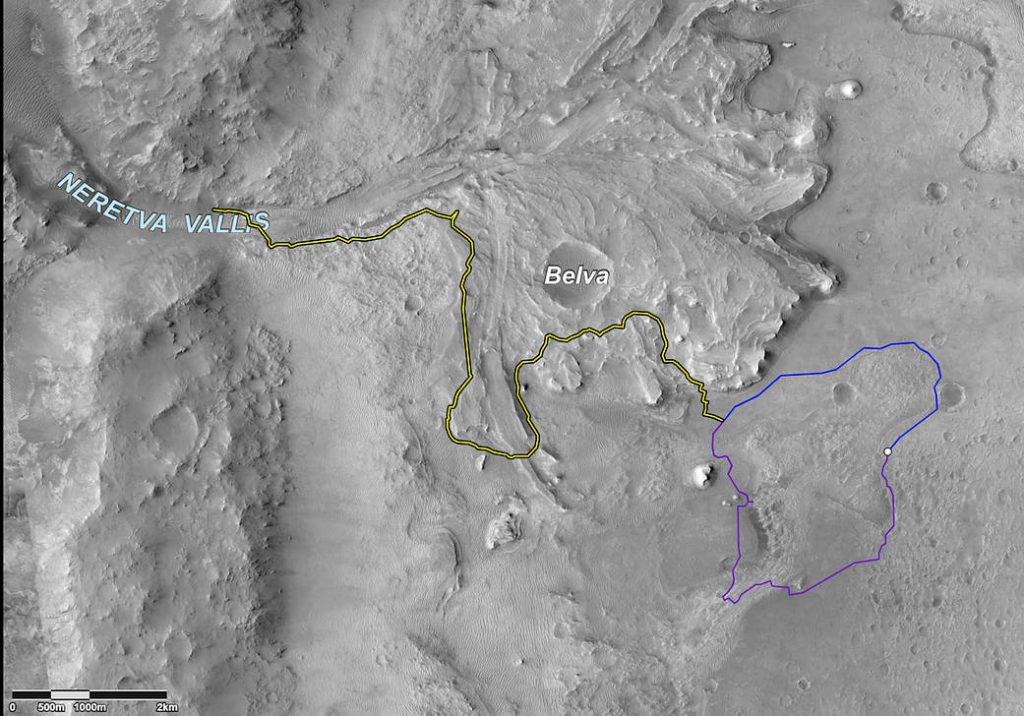 The Road Ahead for Perseverance
The Road Ahead for Perseverance
This image shows two possible routes (blue and purple) to the fan-shaped deposit of sediments known as a delta for NASA’s Perseverance rover, which landed at the spot marked with a white dot in Mars’ Jezero Crater.
 Perseverance View of the Delta in Jezero Crater
Perseverance View of the Delta in Jezero Crater
From its landing site, “Octavia E. Butler Landing,” NASA’s Perseverance rover can see a remnant of a fan-shaped deposit of sediments known as a delta with its Mastcam-Z instrument
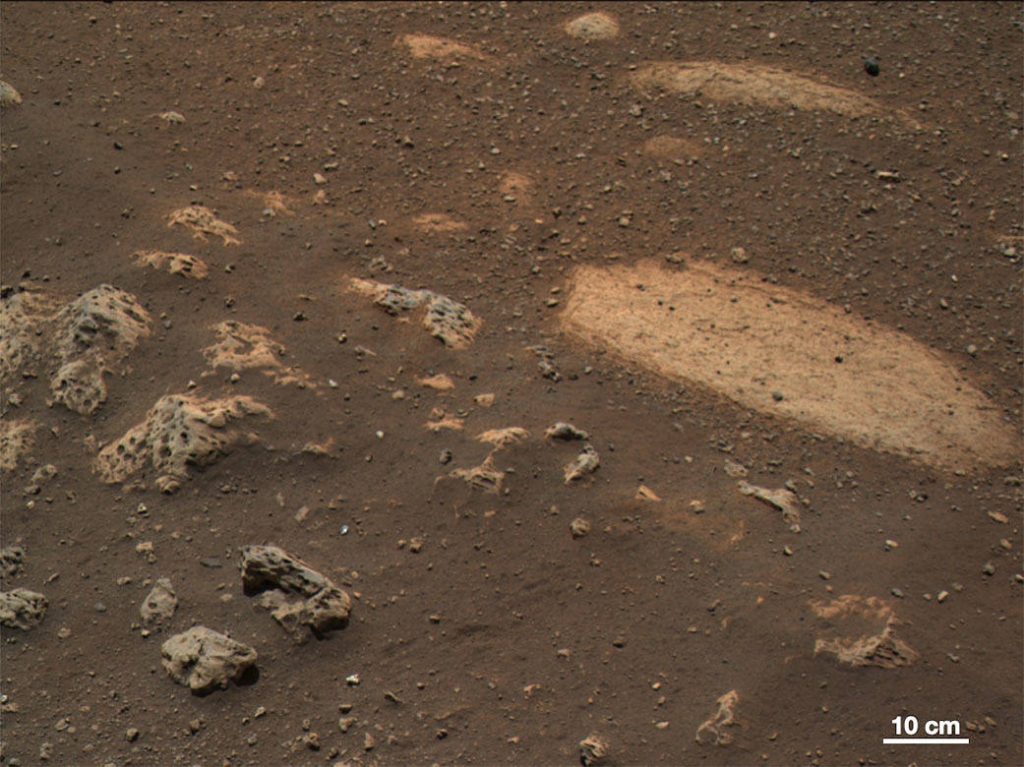 A Target for Perseverance’s SuperCam
A Target for Perseverance’s SuperCam
Taken Feb. 22, 2021, this image from the Mastcam-Z instrument on NASA’s Perseverance rover shows the first target for analysis by the rover’s SuperCam instrument
 Welcome to ‘Octavia E. Butler Landing’
Welcome to ‘Octavia E. Butler Landing’
NASA has named the landing site of the agency’s Perseverance rover “Octavia E. Butler Landing,” after the science fiction author Octavia E. Butler.
 Flexing Perseverance’s Robotic Arm
Flexing Perseverance’s Robotic Arm
This set of images shows parts of the robotic arm on NASA’s Perseverance rover flexing and turning during its first checkout after landing on Mars
 Perseverance Is Roving on Mars
Perseverance Is Roving on Mars
This image was taken during the first drive of NASA’s Perseverance rover on Mars on March 4, 2021
 Mastcam-Z’s First 360-Degree Panorama
Mastcam-Z’s First 360-Degree Panorama
This is the first 360-degree panorama taken by Mastcam-Z, a zoomable pair of cameras aboard NASA’s Perseverance Mars rover
 Navcam View of Perseverance’s Rover Deck
Navcam View of Perseverance’s Rover Deck
The Navigation Cameras, or Navcams, aboard NASA’s Perseverance Mars rover captured this view of the rover’s deck on Feb. 20, 2021
 Perseverance Navcams 360-Degree Panorama
Perseverance Navcams 360-Degree Panorama
Panorama, taken on Feb. 20, 2021, by the Navigation Cameras, or Navcams, aboard NASA’s Perseverance Mars rover
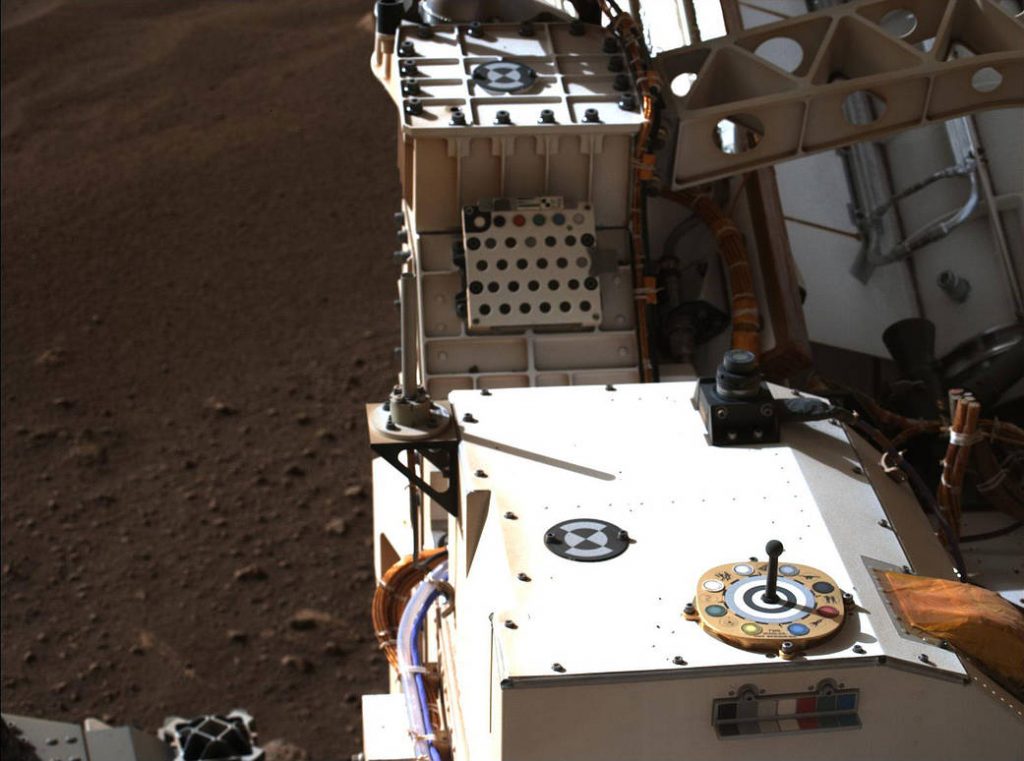 Mastcam-Z Looks at Its Calibration Target
Mastcam-Z Looks at Its Calibration Target
Mastcam-Z, a pair of zoomable cameras aboard NASA’s Perseverance rover
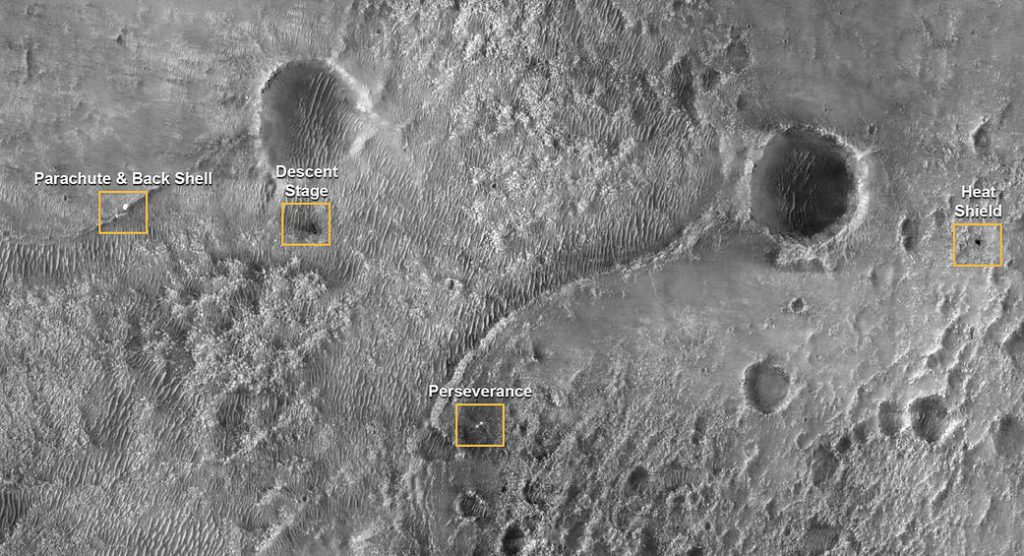 Perseverance and Mars 2020 Spacecraft Components on the Surface
Perseverance and Mars 2020 Spacecraft Components on the Surface
This first image of NASA’s Perseverance Rover on the surface of Mars from the High Resolution Imaging Experiment (HiRISE) camera aboard NASA’s Mars Reconnaissance Orbiter (MRO) shows the many parts of the Mars 2020 mission landing system that got the rover safely on the ground.
This high-resolution image shows one of the six wheels aboard NASA’s Perseverance Mars rover, which landed on Feb. 18, 2021. The image was taken by one of Perseverance’s color Hazard Cameras (Hazcams).
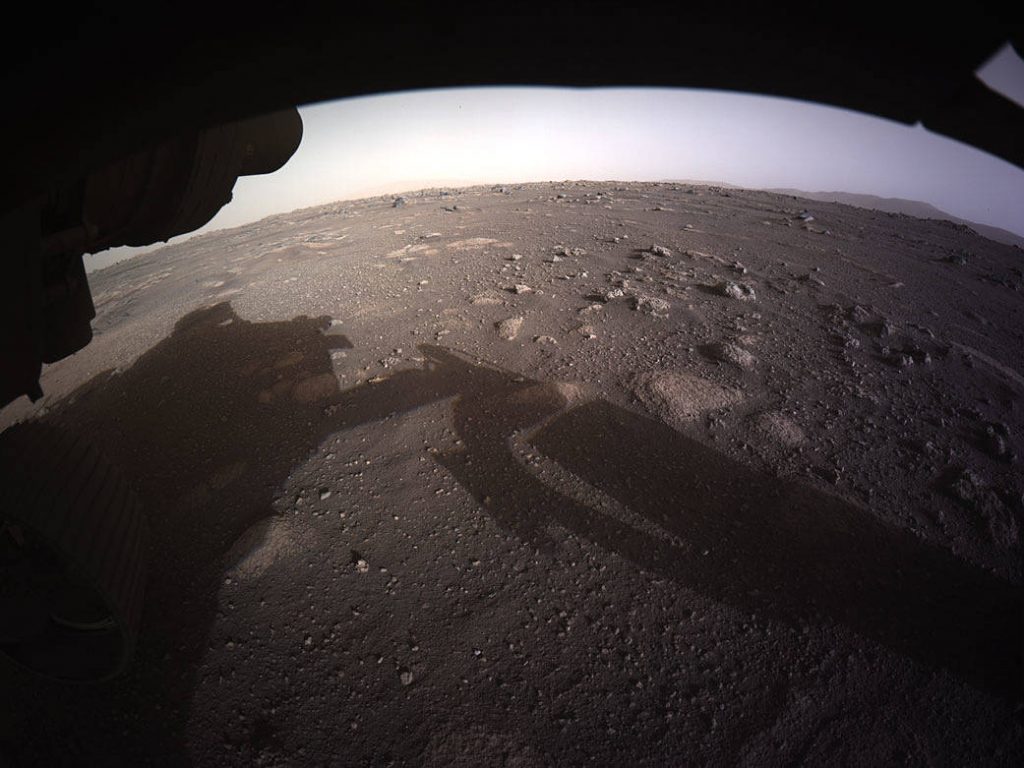 Perseverance’s First Full-Color Look at Mars
Perseverance’s First Full-Color Look at Mars
This is the first high-resolution, color image to be sent back by the Hazard Cameras (Hazcams) on the underside of NASA’s Perseverance Mars rover after its landing on Feb. 18, 2021.
Perservence Gets Ready to Touch Down
Perseverance landed on Mars on Feb. 18, 2021.
For more information, please visit the following links:
https://www.nasa.gov/multimedia/imagegallery/iotd.html
https://nasasearch.nasa.gov/search?query=latest+images&affiliate=nasa&utf8=%E2%9C%93
https://www.nasa.gov/mission_pages/mars/main/index.html
https://www.nasa.gov/perseverance/videos
Preparing for First Flight on Mars on This Week @NASA – March 26, 2021
Mar 26, 2021 NASA
Preparing for first flight on Mars, making a splash with Orion, and the space station’s next crew prepares for launch … a few of the stories to tell you about – This Week at NASA! Download Link: https://images.nasa.gov/details-NHQ_2…? Producer Credit: Andre Valentine Editor: Sonnet Apple Music: Universal Production Music/”Another Way of Winning”
See the Earth Mission NISAR Under Construction in JPL’s Clean Room
Mar 26, 2021 NASA Jet Propulsion Laboratory
No bunny suit required! Come behind-the-scenes with NISAR mission experts to learn all about this joint NASA-ISRO satellite designed to spot potential natural hazards on our planet and how melting land ice will affect sea level rise. Speakers: Paul Rosen, project scientists, JPL Wendy Edelstein, instrument manager, JPL Note: Due to technical difficulties, there was a short gap in coverage at 14:40? in the feed of the original live stream on March 25, 2021. Credit: NASA/JPL-Caltech
https://www.youtube.com/watch?v=PNHrosOsYT0
Mars in 4k: Images from Mars by Perseverance Rover
Mar 28, 2021 common science
See the stunning images of Mars captured by Perseverance Rover New images of Mars in 4k by Perseverance Rover Images of Mars in 4k by Perseverance Rover Mars Rocks images in 4k Images from Mars in 4k See what NASA’s Perseverance Rover Captures On Mars in absolutely stunning 4K. #4k? #perseverance? #NASA? ———————————————————————————————————— Hi this is common science, it is an educational channel. This channel is all about science topic related to biological science and physical science including: physics, chemistry, mathematics, biology, astronomy, geology, geography, statistics, zoology, botany, #commonSCIENCE?
Mars 2020 and the Importance of Planetary Protection
Streamed live on Mar 23, 2021 Smithsonian National Air and Space Museum
One exciting part of the Mars 2020 mission – which features the Perseverance rover that landed on Mars last month — is the collection of Mars rocks for possible return to Earth. In order to preserve the integrity of these samples, we have to make sure that no Earth germs hitched a ride to the Red Planet with the rover. Tune in March 23 at 8 pm ET as Moo Cooper, the Planetary Protection Lead Engineer for the Mars 2020 mission, shares a mission overview and the Planetary Protection actions taken by her team and why Planetary Protection is important. Register: https://s.si.edu/3qQkpry? The Exploring Space Lecture Series is made possible by the generous support of Aerojet Rocketdyne and United Launch Alliance.
NASA Previews First Flight of Mars Helicopter (Media Briefing)
Streamed live on Mar 23, 2021 NASA Jet Propulsion Laboratory
The Ingenuity Mars helicopter, which arrived with the Perseverance rover, is a technology demonstration that will attempt the first-ever powered, controlled flight on another world. The teams operating Ingenuity and Perseverance have now chosen the flight zone where the helicopter will conduct its operations for up to 31 days (30 sols, or Mars days). Join NASA experts to discuss upcoming milestones and get answers to your questions. Speakers are expected to include: Lori Glaze, director of NASA’s Planetary Science Division, NASA Headquarters, Washington Bobby Braun, director for planetary science, NASA’s Jet Propulsion Laboratory (JPL) in Southern California J. (Bob) Balaram, Ingenuity chief engineer, JPL Håvard Grip, Ingenuity chief pilot, JPL Farah Alibay, Perseverance integration lead for Ingenuity, JPL Credit: NASA/JPL-Caltech
The Universe: Human Life on Mars is Coming Soon (S2, E13) | Full Episode | History
Mar 22, 2021 HISTORY
Space colonization is no longer the fodder of science fiction, it is becoming a reality. Examine the efforts underway to establish a human colony on Mars, including how they plan to grow food, in Season 2, Episode 13, “Colonizing Space.” #TheUniverse? Subscribe for more from The Universe and other great The HISTORY Channel shows: http://histv.co/SubscribeHistoryYT? Find out more about the show and watch full episodes on our site: http://www.history.com/shows/? Check out exclusive The HISTORY Channel content: History Newsletter – https://histv.co/newsletter? Website – https://histv.co/History? Facebook – https://histv.co/Facebook? Twitter – https://histv.co/Twitter? HISTORY® is the leading destination for award-winning original series and specials that connect viewers with history in an informative, immersive, and entertaining manner across all platforms. The network’s all-original programming slate features a roster of hit series, premium documentaries, and scripted event programming
 Map of Ingenuity Helicopter Flight Zone
Map of Ingenuity Helicopter Flight Zone
This image shows where NASA’s Ingenuity Mars Helicopter team will attempt its test flights
This image shows where NASA’s Ingenuity Mars Helicopter team will attempt its test flights. Helicopter engineers added the locations for the rover landing site (also known as “Octavia E. Butler Landing”), the airfield (the area where the helicopter will take off and return), and the flight zone (the area within which it will fly) on an image taken by the High Resolution Imaging Experiment (HiRISE) camera aboard NASA’s Mars Reconnaissance Orbiter.
Some small rainbow-like color distortions (which do not actually appear on the terrain of Mars) are seen in this image near the landing location because of the way pre- and post-landing color images were merged.
The Ingenuity Mars Helicopter technology demonstration activity is supported by NASA’s Science Mission Directorate, the NASA Aeronautics Research Mission Directorate, and the NASA Space Technology Mission Directorate.
NASA’s Jet Propulsion Laboratory built and manages operations of Perseverance and Ingenuity for the agency. Caltech in Pasadena, California, manages JPL for NASA.
Credit: NASA/JPL-Caltech/University of Arizona
Last Updated: Mar 24, 2021
Editor: Tony Greicius
Tags: Jet Propulsion Laboratory, Perseverance Mars Rover
Mar 23, 2021
RELEASE 21-033
NASA Ingenuity Mars Helicopter Prepares for First Flight
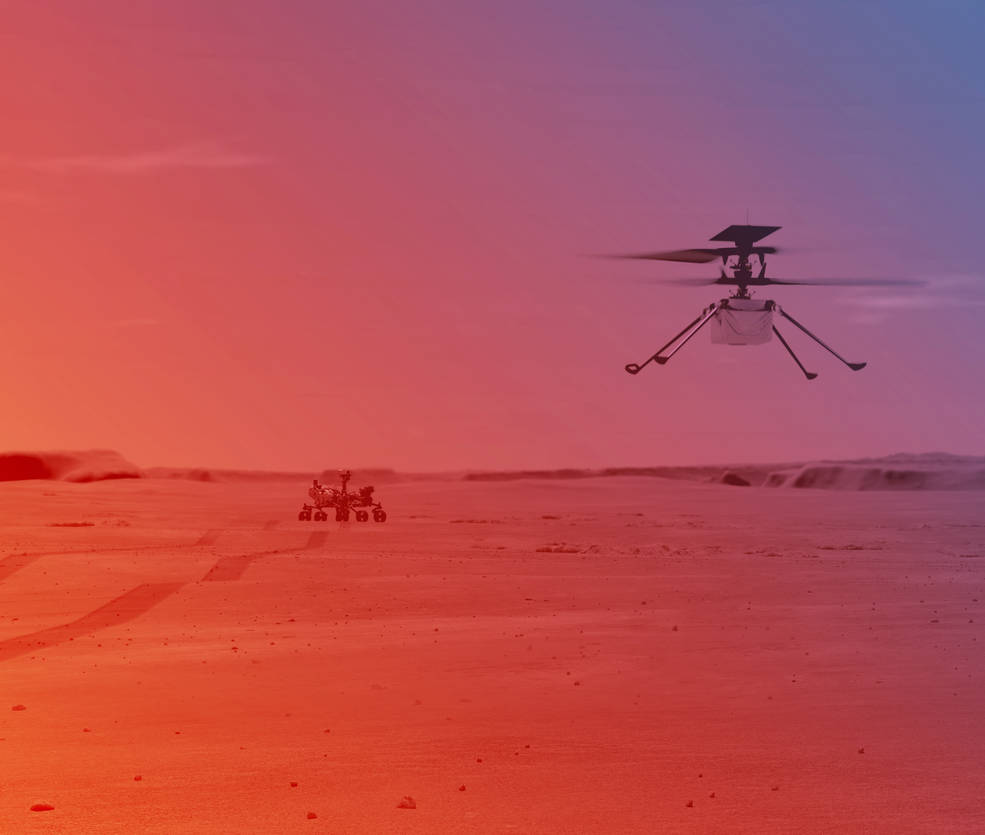 An illustration of NASA’s Ingenuity Helicopter flying on Mars
An illustration of NASA’s Ingenuity Helicopter flying on Mars
Credits: NASA/JPL-Caltech
NASA is targeting no earlier than April 8 for the Ingenuity Mars Helicopter to make the first attempt at powered, controlled flight of an aircraft on another planet. Before the 4-pound (1.8-kilogram) rotorcraft can attempt its first flight, however, both it and its team must meet a series of daunting milestones.
Ingenuity remains attached to the belly of NASA’s Perseverance rover, which touched down on Mars Feb. 18. On March 21, the rover deployed the guitar case-shaped graphite composite debris shield that protected Ingenuity during landing. The rover currently is in transit to the “airfield” where Ingenuity will attempt to fly. Once deployed, Ingenuity will have 30 Martian days, or sols, (31 Earth days) to conduct its test flight campaign.
“When NASA’s Sojourner rover landed on Mars in 1997, it proved that roving the Red Planet was possible and completely redefined our approach to how we explore Mars. Similarly, we want to learn about the potential Ingenuity has for the future of science research,” said Lori Glaze, director of the Planetary Science Division at NASA Headquarters. “Aptly named, Ingenuity is a technology demonstration that aims to be the first powered flight on another world and, if successful, could further expand our horizons and broaden the scope of what is possible with Mars exploration.”
Flying in a controlled manner on Mars is far more difficult than flying on Earth. The Red Planet has significant gravity (about one-third that of Earth’s) but its atmosphere is just 1% as dense as Earth’s at the surface. During Martian daytime, the planet’s surface receives only about half the amount of solar energy that reaches Earth during its daytime, and nighttime temperatures can drop as low as minus 130 degrees Fahrenheit (minus 90 degrees Celsius), which can freeze and crack unprotected electrical components.
To fit within the available accommodations provided by the Perseverance rover, the Ingenuity helicopter must be small. To fly in the Mars environment, it must be lightweight. To survive the frigid Martian nights, it must have enough energy to power internal heaters. The system – from the performance of its rotors in rarified air to its solar panels, electrical heaters, and other components – has been tested and retested in the vacuum chambers and test labs of NASA’s Jet Propulsion Laboratory in Southern California.
“Every step we have taken since this journey began six years ago has been uncharted territory in the history of aircraft,” said Bob Balaram, Mars Helicopter chief engineer at JPL. “And while getting deployed to the surface will be a big challenge, surviving that first night on Mars alone, without the rover protecting it and keeping it powered, will be an even bigger one.”
Deploying the Helicopter
Before Ingenuity takes its first flight on Mars, it must be squarely in the middle of its airfield – a 33-by-33-foot (10-by-10-meter) patch of Martian real estate chosen for its flatness and lack of obstructions. Once the helicopter and rover teams confirm that Perseverance is situated exactly where they want it to be inside the airfield, the elaborate process to deploy the helicopter on the surface of Mars begins.
“As with everything with the helicopter, this type of deployment has never been done before,” said Farah Alibay, Mars Helicopter integration lead for the Perseverance rover. “Once we start the deployment there is no turning back. All activities are closely coordinated, irreversible, and dependent on each other. If there is even a hint that something isn’t going as expected, we may decide to hold off for a sol or more until we have a better idea what is going on.”
The helicopter deployment process will take about six sols (six days, four hours on Earth). On the first sol, the team on Earth will activate a bolt-breaking device, releasing a locking mechanism that helped hold the helicopter firmly against the rover’s belly during launch and Mars landing. The following sol, they will fire a cable-cutting pyrotechnic device, enabling the mechanized arm that holds Ingenuity to begin rotating the helicopter out of its horizontal position. This is also when the rotorcraft will extend two of its four landing legs.
During the third sol of the deployment sequence, a small electric motor will finish rotating Ingenuity until it latches, bringing the helicopter completely vertical. During the fourth sol, the final two landing legs will snap into position. On each of those four sols, the Wide Angle Topographic Sensor for Operations and eNgineering (WATSON) imager will take confirmation shots of Ingenuity as it incrementally unfolds into its flight configuration. In its final position, the helicopter will hang suspended at about 5 inches (13 centimeters) over the Martian surface. At that point, only a single bolt and a couple dozen tiny electrical contacts will connect the helicopter to Perseverance. On the fifth sol of deployment, the team will use the final opportunity to utilize Perseverance as a power source and charge Ingenuity’s six battery cells.
“Once we cut the cord with Perseverance and drop those final five inches to the surface, we want to have our big friend drive away as quickly as possible so we can get the Sun’s rays on our solar panel and begin recharging our batteries,” said Balaram.
On the sixth and final scheduled sol of this deployment phase, the team will need to confirm three things: that Ingenuity’s four legs are firmly on the surface of Jezero Crater, that the rover did, indeed, drive about 16 feet (about 5 meters) away, and that both helicopter and rover are communicating via their onboard radios. This milestone also initiates the 30-sol clock during which time all preflight checks and flight tests must take place.
“Ingenuity is an experimental engineering flight test – we want to see if we can fly at Mars,” said MiMi Aung, project manager for Ingenuity Mars Helicopter at JPL. “There are no science instruments onboard and no goals to obtain scientific information. We are confident that all the engineering data we want to obtain both on the surface of Mars and aloft can be done within this 30-sol window.”
As with deployment, the helicopter and rover teams will approach the upcoming flight test methodically. If the team misses or has questions about an important preflight milestone, they may take one or more sols to better understand the issue. If the helicopter survives the first night of the sequence period on the surface of Mars, however, the team will spend the next several sols doing everything possible to ensure a successful flight, including wiggling the rotor blades and verifying the performance of the inertial measurement unit, as well as testing the entire rotor system during a spin-up to 2,537 rpm (while Ingenuity’s landing gear remain firmly on the surface).
NASA’s Mars Ingenuity helicopter arrived at the Red Planet Feb. 18, 2021. Its mission: to demonstrate the first powered flight on another world.
Credits: NASA/JPL-Caltech
The First Flight Test on Mars
Once the team is ready to attempt the first flight, Perseverance will receive and relay to Ingenuity the final flight instructions from JPL mission controllers. Several factors will determine the precise time for the flight, including modeling of local wind patterns plus measurements taken by the Mars Environmental Dynamics Analyzer (MEDA) aboard Perseverance. Ingenuity will run its rotors to 2,537 rpm and, if all final self-checks look good, lift off. After climbing at a rate of about 3 feet per second (1 meter per second), the helicopter will hover at 10 feet (3 meters) above the surface for up to 30 seconds. Then, the Mars Helicopter will descend and touch back down on the Martian surface.
Several hours after the first flight has occurred, Perseverance will downlink Ingenuity’s first set of engineering data and, possibly, images and video from the rover’s Navigation Cameras and Mastcam-Z. From the data downlinked that first evening after the flight, the Mars Helicopter team expect to be able to determine if their first attempt to fly at Mars was a success.
On the following sol, all the remaining engineering data collected during the flight, as well as some low-resolution black-and-white imagery from the helicopter’s own Navigation Camera, could be downlinked to JPL. The third sol of this phase, the two images taken by the helicopter’s high-resolution color camera should arrive. The Mars Helicopter team will use all information available to determine when and how to move forward with their next test.
“Mars is hard,” said Aung. “Our plan is to work whatever the Red Planet throws at us the very same way we handled every challenge we’ve faced over the past six years – together, with tenacity and a lot of hard work, and a little Ingenuity.”
A Piece of History
While Ingenuity will attempt the first powered, controlled flight on another planet, the first powered, controlled flight on Earth took place Dec. 17, 1903, on the windswept dunes of Kill Devil Hill, near Kitty Hawk, North Carolina. Orville and Wilbur Wright covered 120 feet in 12 seconds during the first flight. The Wright brothers made four flights that day, each longer than the previous.
A small amount of the material that covered one of the wings of the Wright brothers’ aircraft, known as the Flyer, during the first flight is now aboard Ingenuity. An insulative tape was used to wrap the small swatch of fabric around a cable located underneath the helicopter’s solar panel. The Wrights used the same type of material – an unbleached muslin called “Pride of the West” – to cover their glider and aircraft wings beginning in 1901. The Apollo 11 crew flew a different piece of the material, along with a small splinter of wood from the Wright Flyer, to the Moon and back during their iconic mission in July 1969.
More About Ingenuity
The Ingenuity Mars Helicopter was built by JPL, which also manages the technology demonstration for NASA Headquarters. It is supported by NASA’s Science Mission Directorate, the NASA Aeronautics Research Mission Directorate, and the NASA Space Technology Mission Directorate. NASA’s Ames Research Center and Langley Research Center provided significant flight performance analysis and technical assistance.
At NASA Headquarters, Dave Lavery is the program executive for the Ingenuity Mars Helicopter. At JPL, MiMi Aung is the project manager and J. (Bob) Balaram is chief engineer.
Bring the excitement of Ingenuity into classrooms and homes through NASA’s Office of STEM Engagement toolkit. Educators, students, and families can follow along the mission by building a paper helicopter or coding an Ingenuity video game.
For more information about Ingenuity:
https://go.nasa.gov/ingenuity-press-kit
and
https://mars.nasa.gov/technology/helicopter
More About Perseverance
A key objective for Perseverance’s mission on Mars is astrobiology, including the search for signs of ancient microbial life. The rover will characterize the planet’s geology and past climate, pave the way for human exploration of the Red Planet, and be the first mission to collect and cache Martian rock and regolith (broken rock and dust).
Subsequent NASA missions, in cooperation with ESA (European Space Agency), would send spacecraft to Mars to collect these sealed samples from the surface and return them to Earth for in-depth analysis.
JPL, which is managed for NASA by Caltech in Pasadena, California, built and manages operations of the Perseverance rover.
For more about Perseverance:
and
For more images related to this release, go to:
-end-
Alana Johnson / Grey Hautaluoma
NASA Headquarters, Washington
202-672-4780 / 202-358-0668
alana.r.johnson@nasa.gov / grey.hautaluoma-1@nasa.gov
DC Agle
Jet Propulsion Laboratory, Pasadena, Calif.
818-393-9011
agle@jpl.nasa.gov
Last Updated: Mar 24, 2021
Editor: Sean Potter
Tags: Jet Propulsion Laboratory, Moon to Mars, Perseverance Mars Rover
NASA’s Mars Helicopter, Ingenuity (UHD Trailer)
Apr 29, 2020 NASA Jet Propulsion Laboratory
NASA’s Mars Helicopter, Ingenuity, is set to arrive at the Red Planet on Feb. 18, 2021. Its mission: to demonstrate the first powered flight on another world. For more information, visit https://mars.nasa.gov/technology/heli…? Credit: NASA/JPL-Caltech
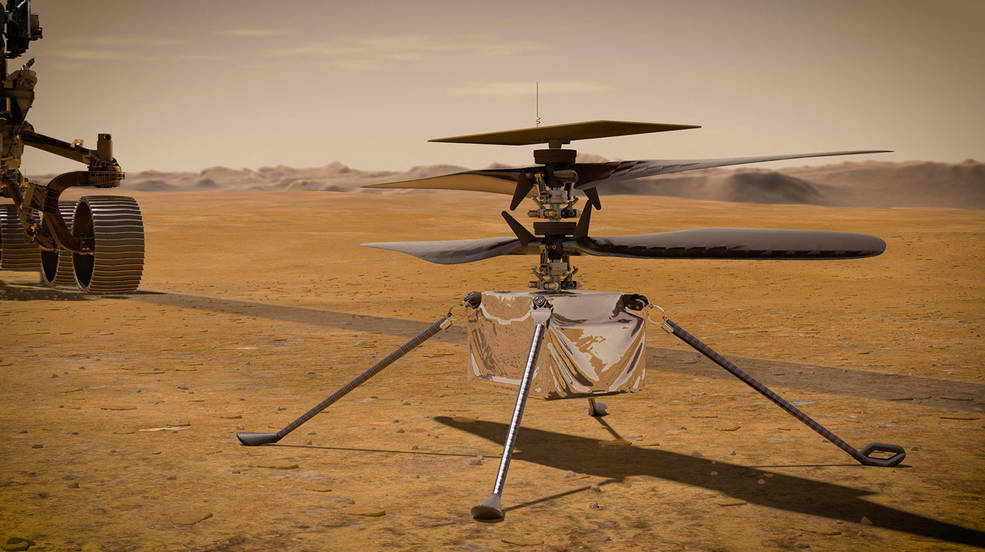
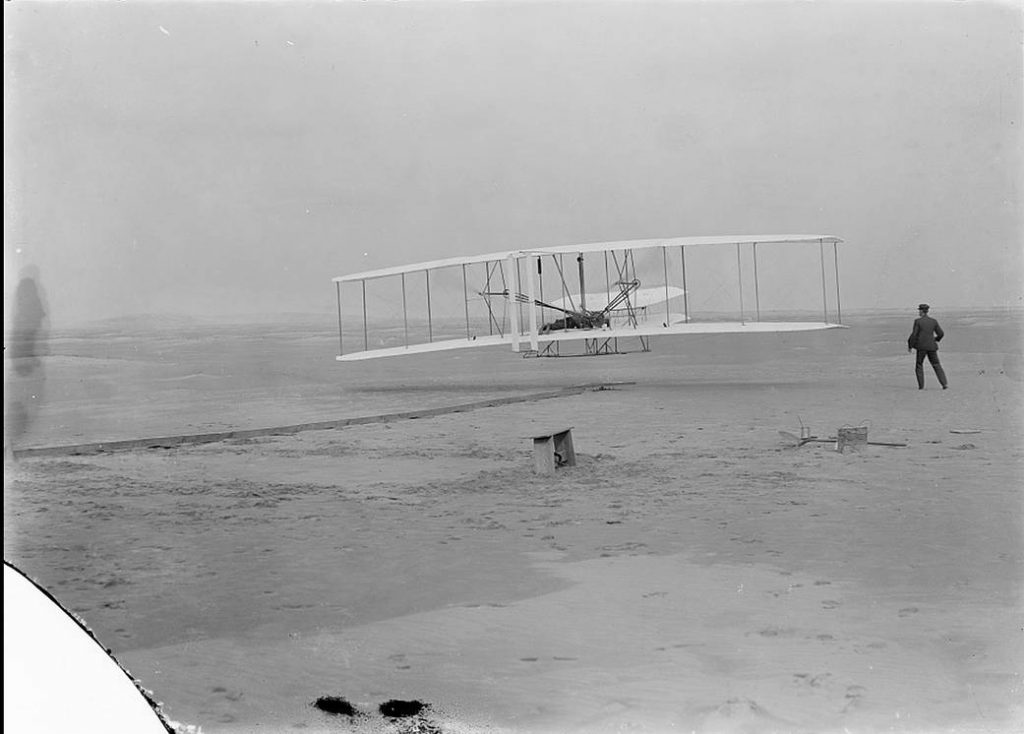


Leave a Reply